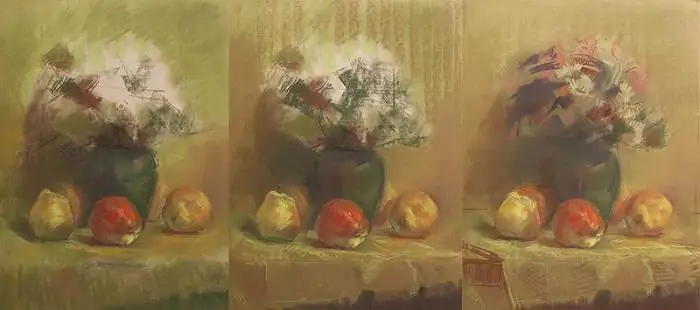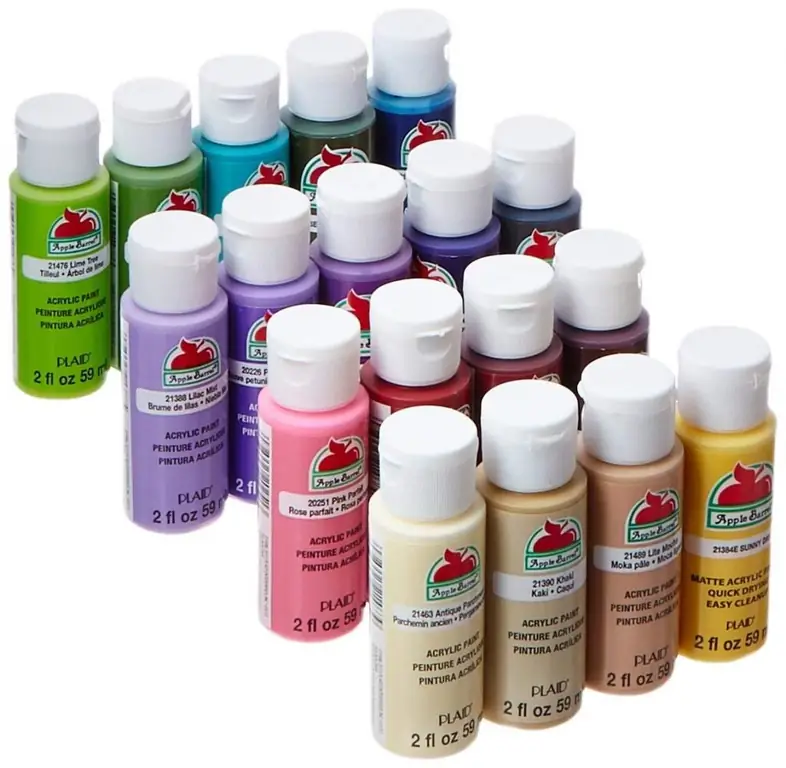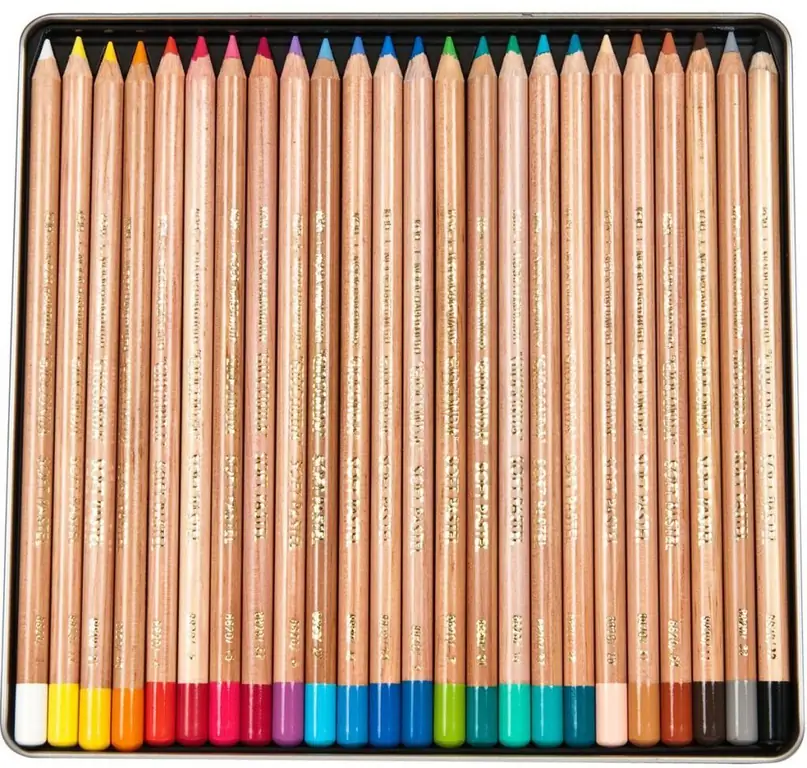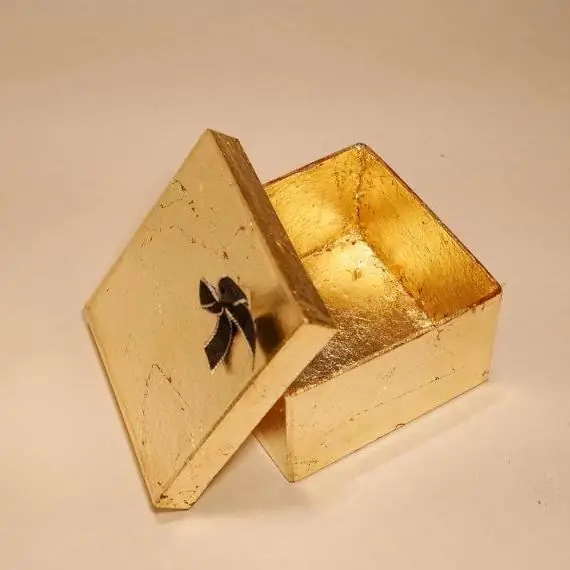2025 Author: Leah Sherlock | [email protected]. Last modified: 2025-01-24 17:46:38
Currently, chemists and technologists manage to find an alternative option - to invent a material that, in terms of its characteristics and external data, is in no way inferior to real gold used in arts and crafts! Meet, this is potal…
Description
What is potal? This is a material (varieties will be discussed later), which is successfully used in decorative gilding of surfaces - huge and small, smooth and not very smooth. It helps the craftsman to create an imitation of gold, silver or bronze plating on various surfaces.
It is also known that potal is such a truly modern imitator of gold leaf. It comes in the form of thin leaves or strips of golden color (like foil) made of an alloy of copper and zinc, and is liquid.

As noted above, this material is not only gold, but also silver and bronze.
The potal is used for creative surface finishing of products made of wood, ceramics, glass, cardboard, bone, ferrous metals, plaster and others.
Potali Varieties
1. Liquid potal - is a chrome paint with a metallic sheen. She isconsists of varnishes, pigments and solvents.
Some craftsmen, perhaps, do not rank this variety as a "potal" material, calling it an imitation of a potal. But still, just like sheet, it creates a beautiful smooth surface of golden (silver or bronze) color.
She has a pungent smell.
2. Potal sheet - a very common and more convenient type of material. And the most used!
The sheet potal is especially good when it is necessary to cover a very large surface.
As a rule, it is produced and delivered to the consumer in the form of so-called books 14x14 or 16x16 centimeters. There are about 25 sheets in one book, and each of them is separated by a piece of thin parchment paper.
It also happens in colors of gold, silver, copper.
3. Potal "crumb" - slightly loose material. It is successfully applied when covering imperfectly smooth surfaces. For example, it can be rims, lines, with stencil technique.
And the crumb can be of different shades or colors, which contributes to an interesting decorative solution in the process of its application.
4. Rolled leaf - made in rolls about 50 meters long and 1-15 centimeters wide. It is used when it is necessary to cover seams and joints or a very flat surface.
5. Transfer potal is very economical in its application. Each leaf is applied to the thinnest paper, film, tracing paper. And it can be used many times - until all the material on the surface of thisfilm.
Sequence of material application
The technology of applying potali has its own characteristics, but in general, everything is quite simple and clear.
1. Sheet potal. It is good to apply the material on a previously degreased, primed surface.
Also, before applying the potal, it is necessary to treat the surface with special glue (water or oil based) or milk for gilding. If a water-based adhesive is used, the surface is ready to be applied directly to it after 15-20 minutes. If the glue is oil-based, then you will have to wait about 12 hours.

Next, a sweat sheet is taken and transferred to the surface already prepared for it and leveled with a thin cloth to remove various wrinkles and air layers.
In order for the gilded surface to retain its shine and freshness for as long as possible, it is necessary to apply a special shellac varnish or any other varnish designed to protect the surface from mechanical damage.
2. Liquid potal. It is applied, as a rule, on a metal surface, glass, wood, plastic, gypsum, ceramics. The material has a fairly uniform dense density, does not oxidize, and a sufficiently high degree of water resistance.
It is recommended to use a flat brush or a sponge made of foam rubber.
The surface to be painted must be cleaned and degreased without fail.

Paint containerShake lightly before use.
As a rule, the potal is applied in several layers. But it is important to remember that each subsequent layer is applied only on a well-dried previous one! On average, potal dries for a day.
You can use an airbrush - such a special sprayer for liquid sweat. Then the layer dries for 1-2 hours. This option is, of course, more suitable if the work needs to be completed in the shortest possible time.
Material advantages
Liquid potal is designed to restore the color of the gold (silver, bronze) coating on objects. This type of material is quite easy to use and has a relatively low cost compared to sheets or rolls.
Leaf potal is used for design and creativity. It can be perfectly used both in interior design and in the processing of dishes, and in other creative and decorative works (for example, decoupage).

And also sheet (mirror) potal is a very high-quality substitute for gold or silver leaf. It is as easy to use as real gold leaf. The result is a perfect mirror surface.
The work of the master using potal
This section will describe the step-by-step implementation of specific work with potal - a wooden hanger for the hallway. Two techniques of decorative art are used here at the same time: decoupage and potal painting.

Materials for work: a wooden blank in the forma pine board measuring 40x25 centimeters, a round medallion with a diameter of 10 centimeters, hooks for a hanger, “crumbs” gold leaf (gold and silver colors), water-based glue for sweating, a napkin and a printout for decoupage, glue for the same technique, white primer, acrylic contour for glass surface.
Creative work begins with the fact that the surface of the wooden board is slightly rubbed with sanding paper until it is smooth. Then, without preliminary priming, using the decoupage technique, a special napkin is glued, or rather, its fragment with the pattern you like. After drying again with sanding paper, the surface is rubbed to a perfectly smooth surface.
The round medallion is primed, then dried and also rubbed with sanding paper. Glue for the gilding is applied to its surface, after it dries, the gilding itself is silver in color. After drying, the surface is polished again.
The contour lines of a bird and twigs are depicted on the medallion with the help of a stencil. Then glue for sweating is applied to them and the material itself is now golden in color.
As a result, the medallion is covered with several layers of varnish.
Meanwhile, work continues on the wooden base for the hanger. With a toothpick (previously moistened with sweat glue), the pattern of birds, twigs, stems, and so on is specified. All these motifs are covered with sweat.
After drying, the entire hanger is varnished. The medallion is fixed and the hooks are screwed on.
Who would have thought that such a potal could create a real miracle - decorate like thatjob!
Material cost
The price of potali liquid: a capacity of 50 ml - 450 rubles, 100 ml - 520 rubles.
In rolls - from 370 rubles to 4500 rubles per roll - depending on its width, length and manufacturer.

There are many suppliers of this material: both in Russia and in Germany. For every taste.
Conclusions
Still, the advantages of the material are obvious! Due to the fact that gold leaf is such an interesting and inexpensive material, restorers have a wonderful opportunity to transform ancient treasures: icons, paintings, frescoes, sculptures. And thus, to preserve the legacy left to us from distant ancestors. And also potal allows masters to create new masterpieces!
Recommended:
Soloist of the group "Technology" Vladimir Nechitailo. Members and discography of the group "Technology"

The debut of "Technology" took place at the very beginning of the 90s. She became the first representative of synth-pop on the Russian stage. The soloists of the Tekhnologiya group Nechitailo and Ryabtsev became pop stars in the blink of an eye. They remain famous to this day
Still life pastel: technology description, features

Very often beginning artists cannot decide on the material. Often the choice is between watercolor and oil. However, there is another group of artistic materials - "soft". It is pastel. This material is pleasant and easy to work with
Painting on the skin with acrylic paints: features and technology

You can paint a lot with paints: leather furniture, shoes, bags and wallets, do easel work on leather instead of canvas, make mosaics from pieces of material painted with acrylic and so on. This article will tell you about painting techniques, about the features of working with acrylic paints for different types of skin, about spot and other types of painting
Pastel pencils: types, description, features of drawing technology

What is pastel? About the quality and safety of the material. The main types of pastels are pencils, soft, oil, hard. Leading pencil manufacturers: product characteristics. What is a "Divage Pastel" pencil?
Elizabethan baroque in the architecture of St. Petersburg: description, features and features

Elizabethian Baroque is an architectural style that arose during the reign of Empress Elizabeth Petrovna. It flourished in the middle of the 18th century. The architect, who was the most prominent representative of the style, was Bartolomeo Francesco Rastrelli (1700-1771). In honor of him, the Elizabethan baroque is often called "Rastrelli"

